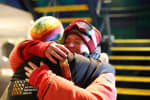The search for the sources of ultra-high-energy cosmic rays (UHECRs) is not a simple one. UHECRs, which are a mixture of protons and heavy nuclei, are the highest energy particles ever measured. They should produce “hotspots” of high-energy neutrinos if they interact with other particles near their point of origin. Six years ago, a first […]
News
Week 9 at the Pole
Last week was somewhat busy at the South Pole for IceCube’s winterovers. There were a couple of troubleshooting issues regarding the detector, and a trip or two out to the IceCube Lab (ICL). That’s Moreno below checking the status of some fans on computers in the ICL. On the recreational side of things, the winterovers […]
Improved reconstruction of low-energy events in IceCube
Every six minutes, a neutrino flies through the Antarctic ice sheet, and close to an IceCube sensor—also called a DOM—it interacts with a molecule of ice and creates a tiny amount of light that triggers data-taking for an event in the IceCube neutrino detector. If this is a high-energy event, a beautiful track or a […]
Week 8 at the Pole
It’s getting colder and colder at the South Pole. And when temperatures get too low, the winterovers can’t use snow vehicles to get around. But IceCube’s winterovers still had snow accumulation measurements to take last week, and the weather was not looking too favorable. Luckily, they did manage to find some open windows of opportunity […]
Week 7 at the Pole
Seasons come and seasons go. At the South Pole, you get only two seasons, and last week the South Pole station closed for…winter! (Isn’t it always winter there?) The last two planes carrying away summer workers left the Pole last week. The remaining winterovers said their final good-byes and then set themselves to the tasks […]
Confirmation of whether galactic X-ray binaries emit high-energy neutrinos awaits IceCube-Gen2
X-ray binaries (XRB) consist of a compact object, such as a neutron star or a black hole, and a noncompact, companion star. When they are close enough, material is pulled off the star and drawn onto the compact companion, releasing intense X-rays that make them some of the most luminous sources in the sky. Microquasars, […]
Thomas K. Gaisser, former IceCube spokesperson, dies at 81
Thomas K. Gaisser, the Martin A. Pomerantz Professor of Physics at the University of Delaware, passed away on Sunday, February 20, 2022, after a short illness. He was 81. Tom, as his friends and colleagues called him, was a pivotal researcher in the field of cosmic-ray physics. Since the late 1970s, he has inspired […]
Week 6 at the Pole
Last week was quiet for the IceCube detector but not so quiet for the South Pole station—lots of activity going on there. The third and final South Pole traverse of the season, SPOT3, arrived with its long load of fuel bladders, shown above and below, under a sun halo. SPOT3 was there just long enough […]
New IceTop measurements shed light on the cosmic-ray muon puzzle
It took a solar eclipse and a balloon flying up to 5,300 meters to point to outer space as the origin of the ionizing radiation in the atmosphere. The discovery of cosmic rays was made by Victor Hess in 1912 and earned him the Nobel prize in 1936. Since then, scientists around the world use […]
Week 5 at the Pole
Last week, after quite a few delays, the last 25 members of the South Pole winter crew arrived. It is not typical for half of the crew to arrive so late in the season, but international Covid precautions among other things have complicated the logistics of preparations and travel. The station will be closing soon […]









